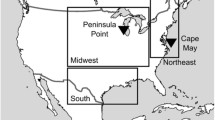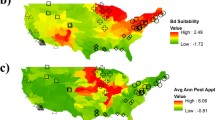Abstract
Experimental research has identified many putative agents of amphibian decline, yet the population-level consequences of these agents remain unknown, owing to lack of information on compensatory density dependence in natural populations. Here, we investigate the relative importance of intrinsic (density-dependent) and extrinsic (climatic) factors impacting the dynamics of a tree frog (Hyla arborea) population over 22 years. A combination of log-linear density dependence and rainfall (with a 2-year time lag corresponding to development time) explain 75% of the variance in the rate of increase. Such fluctuations around a variable return point might be responsible for the seemingly erratic demography and disequilibrium dynamics of many amphibian populations.

Similar content being viewed by others
References
Alford RA, Richard SJ (1999) Global amphibian declines: a problem in applied ecology. Annu Rev Ecol Syst 30:133–165
Altwegg R (2003) Multistage density dependence in an amphibian. Oecologia 136:46–50
Altwegg R, Reyer HU (2003) Patterns of natural selection on size at metamorphosis in water frogs. Evolution 57:872–882
Anholt BR, Hotz H, Guex G, Semlitsch RD (2003) Overwinter survival of Rana lessonae and its hemiclonal associate Rana esculenta. Ecology 84:391–397
Beebee TJC, Denton JS, Buckley J (1996). Factors affecting population densities of adult natterjack toads Bufo calamita in Britain. J Appl Ecol 33:263–268
Beebee TJC, Griffiths RA (2005) The amphibian decline crisis: a watershed for conservation biology? Biol Conserv 125:271–285
Berven KA (1990) Factors affecting population fluctuations in larval and adult stages of the wood frog (Rana sylvatica). Ecology 71:1599–1608
Biek R, Funk WC, Maxell BA, Mills LS (2002) What is missing in amphibian decline research: insights from ecological sensitivity analysis. Conserv Biol 16:728–734
Bjørnstad ON, Grenfell BT (2001) Noisy clockworks: time series analysis of population fluctuations on animals. Science 293:638–643
Bjørnstad ON, Ims RA, Lambin X (1999). Spatial population dynamics: analyzing patterns and processes of population synchrony. Trends Ecol Evol 14:427–432
Blaustein AR, Han B, Fasy B, Romansic J, Scheessele EA, Anthony RG, Marco A, Chivers DP, Belden LK, Kiesecker JM, Garcia T, Lizana M, Kats LB (2004) Variable breeding phenology affects the exposure of amphibian embryos to ultraviolet radiation and optical characteristics of natural waters protect amphibians from UV-B in the U.S. Pacific northwest: comment. Ecology 85:1747–1754
Burnham KP, Anderson DR (2002) Model selection and multi-model inference. Springer, Berlin Heidelberg New York
Carlson A, Edenhamn P (2000) Extinction dynamics and the regional persistence of a tree frog metapopulation. Proc R Soc Lond B 267:1311–1313
Collins JP, Storfer A (2003) Global amphibian declines: sorting the hypotheses. Divers Distrib 9:89–98
Conroy SDS, Brook BW (2003) Demographic sensitivity and persistence of the threatened white- and orange-bellied frogs of Western Australia. Popul Ecol 45:105–114
Dennis B, Taper ML (1994) Density dependence in time series observations of natural populations: estimation and testing. Ecol Monogr 64:205–224
Dennis B, Otten MRM (2000) Joint effects of density dependence and rainfall on abundance of San Joaquin kit fox. J Wildl Manage 64:388–400
Edenhamn P (1996) Spatial dynamics of the European tree frog (Hyla arborea) in a heterogeneous landscape. Dissertation, Department of Conservation Biology, Swedish University of Agricultural Sciences
Forbes VE, Calow P (2002) Population growth rate as a basis for ecological risk assessment of toxic chemicals. Phil Trans R Soc B 357:1299–1306
Friedl TWP, Klump GM (1997) Some aspects of population biology in the European tree frog, Hyla arborea. Herpetologica 53:321–330
Giacoma C, Kozar T, Pavignano I (1993). Ethological aspects of the biology of Hyla arborea. In: Stumpel AHP, Tester U (eds) Ecology and conservation of the European tree frog. Proceedings of the 1st international workshop on Hyla arborea, Institute for Forestry and Nature Research, Wageningen, pp 21–28
Gompertz B (1825) On the nature of the function expressive of the law of human mortality, and on a new mode of determining the value of life contingencies. Phil Trans R Soc B 115:513–585
Govindarajulu P, Altwegg R, Anholt BR (2005) Matrix model investigations of invasive species control: bullfrogs on Vancouver island. Ecol Appl 15:2161–2170
Grafe T, Kaminsky SK, Bitz JH, Lüssow H, Linsenmair KE (2004) Demographic dynamics of the afro-tropical pig-nosed frog, Hemisus marmoratus: effects of climate and predation on survival and recruitment. Oecologia 141:40–46
Grant A (1998) Population consequences of chronic toxicity: Incorporating density dependence into the analysis of life table response experiments. Ecol Model 105:325–335
Green DM (2003) The ecology of extinction: population fluctuation and decline in amphibians. Biol Conserv 111:331–343
Griffiths RA (2004) Great Crested Newts (Triturus cristatus) in Europe. In: Akçakaya RH, Burgman MA, Kindvall O, Wood CC, Sjögren-Gulve P, Hatfield JS, McCarthy MA (eds) Species conservation and management. Oxford University Press, Oxford, pp 281–291
Halley J, Inchausti P (2002) Lognormality in ecological time series. Oikos 99:518–530
Hatfield JS, Price AH, Diamond DD, True CD (2004) Houston toad (Bufo houstonensis) in Bastrop County, Texas: need for protecting multiple subpopulations. In: Akçakaya RH, Burgman MA, Kindvall O, Wood CC, Sjögren-Gulve P, Hatfield JS, McCarthy MA (eds) Species conservation and management. Oxford University Press, Oxford, pp 292–298
Henle K, Sarre S, Wiegand K (2004) The role of density regulation in extinction processes and population viability analysis. Biodivers Conserv 13:9–52
Heyer RW, Donnelly MA, McDiarmid RW, Hayek LAC, Foster MS (1994). Measuring and monitoring biodiversity: standard methods for amphibians. Smithsonian Institution Press, Washington
Houlahan JE, Findlay CS, Schmidt BR, Meyer AH, Kuzmin SL (2000) Quantitative evidence for global amphibian population declines. Nature 404:752–755
Houlahan JE, Findlay CS, Meyer AH, Kuzmin SL, Schmidt BR (2001) Global amphibian population declines. Nature 412:500
Hurvich CM, Tsai CL (1989) Regression and time series model selection in small samples. Biometrika 76:297–307
Inchausti P, Halley J (2003) On the relation between temporal variability and persistence time in animal populations. J Anim Ecol 72:899–908
IUCN, Conservation International, and NatureServe (2004) Global amphibian assessment. <http://www.globalamphibians.org>. Accessed on 17 January 2006
Jaeger RG (1980) Density-dependent and density-independent causes of extinction of a salamander population. Evolution 34:617–621
Lande R, Engen S, Sæther BE (2003) Stochastic population dynamics in ecology and conservation. Oxford University Press, Oxford
Leigh EG (1981) The average lifetime of a population in a varying environment. J Theor Biol 90:213–239
Marsh DM, Trenham PC (2001) Metapopulation dynamics and amphibian conservation. Conserv Biol 15:40–49
Meyer AH, Schmidt BR, Grossenbacher K (1998) Analysis of three amphibian populations with quarter-century long time-series. Proc R Soc Lond B 265:523–528
McPeek MA, Peckarsky BL (1998) Life histories and the strengths of species interactions: combining mortality, growth, and fecundity effects. Ecology 79:867–879
Pahkala M, Laurila A, Merilä J (2001) Carry-over effects of ultraviolet-B radiation on larval fitness in Rana temporaria. Proc R Soc Lond B 268:1699–1706
Pearman PB (1993) Effects of habitat size on tadpole populations. Ecology 74:1982–1991
Pechmann JHK, Wilbur HM (1994) Putting declining amphibian populations in perspective: natural fluctuations and human impacts. Herpetologica 50:65–84
Pedersen HC, Steen H, Kastdalen L, Brøseth H, Ims RA, Svendsen W, Yoccoz NG (2004) Weak compensation of harvest despite strong density-dependent growth in willow ptarmigan. Proc R Soc Lond B 271:381–385
Pellet J, Guisan A, Perrin N (2004) A concentric analysis of the impact of urbanization on the threatened European tree frog in an agricultural landscape. Conserv Biol 18:1599–1606
Petranka JW (1989) Density-dependent growth and survival of larval Ambystoma: evidence from whole-pond manipulations. Ecology 70:1752–1767
Pribil S, Houlahan JE (2003) Life history strategies associated with local population variability confer regional stability. Proc R Soc Lond B 270:1419–1423
R Development Core Team (2004) R: a language and environment for statistical computing. R foundation for statistical computing, Vienna
Reading CJ (2003) The effects of variation in climatic temperature (1980–2001) on breeding activity and tadpole stage duration in the common toad, Bufo bufo. Sci Total Environ 310:231–236
Reading CJ, Clarke RT (1999) Impacts of climate and density on the duration of the tadpole stage of the common toad Bufo bufo. Oecologia 121:310–315
Ricker WE (1954) Stock and recruitment. J Fish Res Board Can 11:559–923
Rohr JR, Palmer BD (2005) Aquatic herbicide exposure increases salamander desiccation risk eight months later in a terrestrial environment. Environ Toxicol Chem 24:1253–1258
Rohr JR, Sager T, Sesterhenn TM, Palmer BD (2006) Exposure, postexposure, and density-mediated effects of atrazine on amphibians: breaking down net effects into their parts. Environ Health Perspect 114:46–50
Saitoh T, Stenseth NC, Bjørnstad ON (1997) Density dependence in fluctuating grey-sided vole populations. J Anim Ecol 66:14–24
Schmidt BR, Feldmann R, Schaub M. (2005) Demographic processes underlying population growth and decline in Salamandra salamandra. Conserv Biol 19:1149–1156
Schmidt BR, Pellet J (2005). Relative importance of population processes and habitat characteristics in determining site occupancy of two anurans. J Wildl Manage 69:884–893
Schmidt BR, Zumbach S (2005) Rote Liste der gefährdeten Amphibien der Schweiz. BUWAL-Reihe, Vollzug Umwelt, p 48
Schoener TW, Spiller DA (1992) Is extinction rate related to temporal variability in population size? An empirical answer for orb spiders. Am Nat 139:1176–1207
Semlitsch RD (1985) Analysis of climatic factors influencing migrations of the salamander Ambystoma talpoideum. Copeia 1985:477–489
Semlitsch RD, Scott DE, Pechmann JHK, Gibbons JW (1996) Structure and dynamics of an amphibian community: evidence from a 16-year study of a natural pond. In: Cody M, Smallwood J (eds) Long-term studies of vertebrate communities. Academic, San Diego, pp 217–248
Shoop CR (1974) Yearly variation in larval survival of Ambystoma maculatum. Ecology 55:440–444
Smith DC (1983) Factors controlling tadpole populations of the chorus frog (Pseudacris triseriata) on Isle Royale, Michigan. Ecology 64:501–510
Smith MA, Green DM (2005) Dispersal and the metapopulation paradigm in amphibian ecology and conservation: are all amphibian populations metapopulations? Ecography 28:110–128
Stumpel AHP (1993) The terrestrial habitat of Hyla arborea. In: Stumpel AHP, Tester U (eds) Ecology and conservation of the European tree frog. Proceedings of the 1st international workshop on Hyla arborea, Institute for Forestry and Nature Research, Wageningen, pp 47–54
Stuart SN, Chanson JS, Cox NA, Young BE, Rodrigues ASL, Fischman DL, Waller RW (2004) Status and trends of amphibian declines and extinctions worldwide. Science 306:1783–1786
Sutherland WJ (1996) From individual behaviour to population ecology. Oxford University Press, New York
Sutherland WJ, Norris K (2002) Behavioural models of population growth rates: Implications for conservation and prediction. Phil Trans R Soc Lond B 357:1273–1284
Tester U (1993) Methods and definitions for tree frog research. In: Stumpel AHP, Tester U (eds) Ecology and conservation of the European tree frog. Proceedings of the 1st international workshop on Hyla arborea, Institute for Forestry and Nature Research, Wageningen, pp 21–28
Turchin P (1995) Population regulation: old arguments and a new synthesis. In: Cappuccino N, Price P (eds) Population dynamics. Academic, New York, pp 19–39
Turchin P (2003) Complex population dynamics: a theoretical/empirical synthesis. Princeton University Press, Princeton
Van Buskirk J, Smith DC (1991) Density-dependent population regulation in a salamander. Ecology 72:1747–1756
Vonesh JR, De la Cruz O (2002) Complex life cycles and density dependence: assessing the contribution of egg mortality to amphibian declines. Oecologia 133:325–333
Werner EE (1998) Ecological experiments and a research program in ecology. In: Resetarits WJ, Bernardo J (eds) Experimental ecology. Oxford University Press, New York pp 3–26
Acknowledgements
This work was funded by the Swiss Federal Office for Environment, Forest and Landscape, the Center for Fauna and Nature Conservation (Canton Vaud), and the MAVA Foundation. The Swiss Federal Office for Water and Geology provided data on the river Aare water level. We thank Lori-Jayne Lawson Handley and Jason Rohr for comments on the manuscript.
Author information
Authors and Affiliations
Corresponding author
Additional information
Communicated by Anssi Laurila
Rights and permissions
About this article
Cite this article
Pellet, J., Schmidt, B.R., Fivaz, F. et al. Density, climate and varying return points: an analysis of long-term population fluctuations in the threatened European tree frog. Oecologia 149, 65–71 (2006). https://doi.org/10.1007/s00442-006-0432-1
Received:
Accepted:
Published:
Issue Date:
DOI: https://doi.org/10.1007/s00442-006-0432-1




